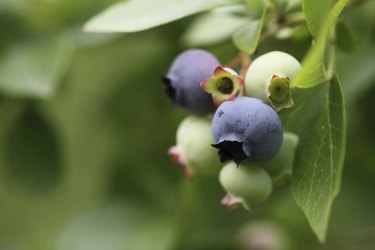
The Sunshine State is home to an astounding array of living things, including exotic and familiar plants. One of them is the wild blueberry plant (Vaccinium spp., USDA plant hardiness zones 3-9), which grows abundantly throughout the state. You may see blueberry bush wild if you're in a wooded or swampy area. Blueberry bushes have a small window of time during which they produce fruit, so you can't identify these plants just by the familiar berries. What does a blueberry bush look like, and what kinds of blueberries grow in Florida?
What Types of Blueberries Grow in Florida?
Video of the Day
Eight wild blueberries are found throughout Florida, though they fall into two main types: rabbiteye (Vaccinium ashei, zones 7-9) and Southern highbush (Vaccinium corymbosum, zones 5-8). Blueberries grow best in a more moderate climate. That means you're more likely to find blueberries in central and northern Florida, but because it is such a tough plant, it thrives almost everywhere.
Video of the Day
Blueberries prefer very moist soil to the point of swampiness. That's one of the reasons they grow so well in Florida, as much of the terrain is damp. They prefer acidic soil (pH of around 4 or 5) and lots of sunlight. However, partial shade is better in parts of Florida that are very hot.
There aren't significant differences between wild blueberries vs. blueberries that are cultivated. These blueberries can sometimes even be the same plant species, though they appear very different because one is pruned and tended.
Huckleberry vs. Blueberry
Even out of the wild and off the branch, huckleberries (Gaylussacia spp., zones 4-7) and blueberries look strikingly similar. Western huckleberries are different from eastern huckleberries; the kind you'd find in Florida do not appear in the Western United States. Both plants are shrubs or bushes from the family Ericaceae. They produce small, round fruit that is ordinarily blue or purple.
One of the easiest ways to distinguish between these two plants is by examining how the berries grow. Blueberries produce fruit in clusters, similar (to the naked eye) to grapes. Huckleberries grow individually on their own twigs. When you split them open, blueberries are pale or white on the inside, while huckleberries maintain their purple or blue hue.
While blueberries and huckleberries taste similar to some people, huckleberries are full of hard seeds. These seeds make them unpleasant to eat, and they taste bitter if you bite into them. Do blueberries have seeds? They do. While some believe the berry is the seed, you can see tiny seeds inside the berry if you bisect it.
Recognizing Wild Blueberry Plants
In the wild, determining whether you found a dwarf huckleberry (Gaylussacia dumosa, zones 8-10) or a blueberry can be difficult. While the blooms are similar, the easiest way to tell them apart is the berries. Huckleberries will have precisely 10 seeds, whereas blueberries can have many more.
What does a blueberry bush look like? A wild blueberry plant is characterized by its berries, which are about 1/2 to 1 inch wide. It's a woody shrub with oval green leaves, and the twigs are a yellowish-green color and turn red during colder months. Most blueberry plants don't grow much larger than a few feet in height and width.
There are two primary ways to tell the difference between Florida's main types of blueberries. Rabbiteye varieties tend to be firmer with thicker skin than Southern highbush. In contrast, Southern highbush blueberry shrubs harvest at least four weeks earlier in the season.